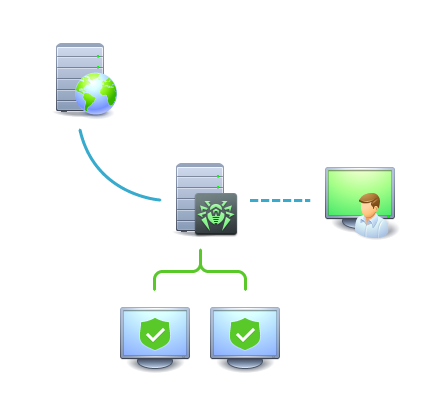Anti-virus Dr.Web for UNIX File Servers can operate both in standalone mode and as a part of an anti-virus network managed by a central protection server. Operation in central protection mode does not require installation of additional software or Dr.Web for UNIX File Servers reinstallation or removal.
•In standalone mode, the protected computer is not connected to an anti-virus network and its operation is managed locally. In this mode, configuration and license key files reside on local disks and Dr.Web for UNIX File Servers is fully controlled from the protected computer. Updates to virus databases are received from Doctor Web update servers.
•In central protection mode, protection of the computer is managed by the central protection server. In this mode, some functions and settings of Dr.Web for UNIX File Servers can be adjusted in accordance with the general (corporate) anti-virus protection policy implemented on the anti-virus network. The license key file used for operating in enterprise mode is received from the central protection server. The key file stored on the local computer, if any, is not used. Statistics on virus events is sent to the central protection server. Updates to virus databases are also received from the central protection server.
•In mobile mode, Dr.Web for UNIX File Servers receives updates from Doctor Web update servers, but operation of Dr.Web for UNIX File Servers is managed with the local settings. The used key file is received from the central protection server.
Central protection concept
Doctor Web solutions for central protection use client-server model (see the picture below).
Workstations and servers are protected by local anti-virus components (herein, Dr.Web for UNIX File Servers) installed on them, which provides for anti-virus protection of remote computers and allows connection between the workstations and the central protection server.

|
Picture 2. Logical structure of the Anti-Virus Network
Local computers are updated and configured from the central protection server. The stream of instructions, data and statistics in the anti-virus network goes also through the central protection server. The volume of traffic between protected computers and the central server can be quite sizeable, therefore solutions provide options for traffic compression. To prevent leak of sensitive data or substitution of software downloaded onto protected computers, encryption is also supported.
All necessary updates are downloaded to the central protection server from Doctor Web update servers.
Local anti-virus components are configured and managed from the central protection server according to commands received from anti-virus network administrators. Administrators manage central protection servers and topology of anti-virus networks (for example, validate connections to the central protection server from remote computers) and configure operation of local anti-virus components when necessary.
|
Local anti-virus components are not compatible with anti-virus products of other companies or anti-virus solutions of Dr.Web if the latter do not support operation in Central protection mode (for example, version 5.0 of Dr.Web for UNIX File Servers). Installation of two anti-virus programs on the same computer can cause a system crash and loss of important data. Please note that the current version of the Dr.Web for UNIX File Servers suite is not fully implements the central protection mode: central protection server cannot manage operation settings of the product components and cannot send scan tasks for the suite. |
Connecting to Anti-Virus Network
Dr.Web for UNIX File Servers can be connected to an anti-virus network using the esconnect command of the command-line management tool Dr.Web Ctl.
|
Verification of central protection server requires use of public encryption keys, that is, each server is supplied with a unique public key. By default, central protection agent Dr.Web ES Agent does not allow connection to the server unless you provide a file containing a public key for authentication of the used server. Such public key file should be obtained from the administrator of your anti-virus network serviced by the server to which you want to connect Dr.Web for UNIX File Servers. |
If Dr.Web for UNIX File Servers is a part of the anti-virus network, you can switch solution operation between mobile and enterprise modes. The operation mode option is managed with the configuration parameter MobileMode of Dr.Web ES Agent. Note that operation can switch to mobile mode only if it is allowed in the central protection server settings.
Disconnecting from Anti-Virus Network
Dr.Web for UNIX File Servers can be disconnected from the anti-virus network using the esdisconnect command of the command-line management tool Dr.Web Ctl.